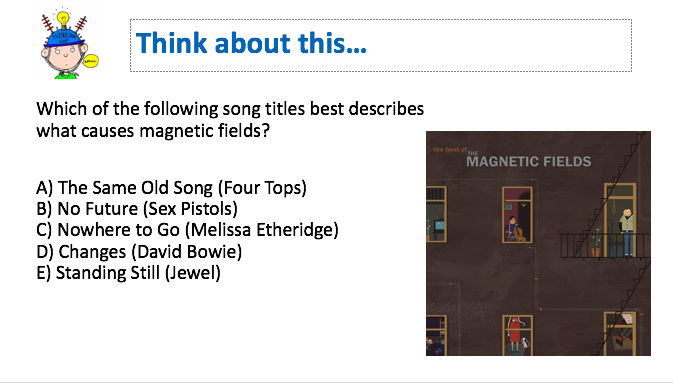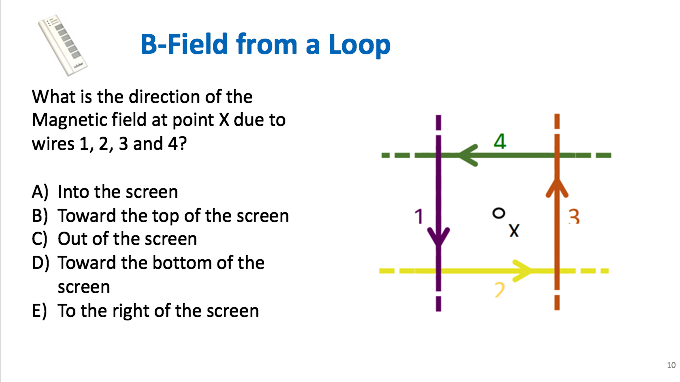Course Format and Philosophy
Whole Class Meeting (Lecture)
A typical Whole Class Meeting or Lecture (they may be used interchangeably in this handbook) could have a two or three different components. The foundations for the lecture are reviewing and extending content from pre-lecture readings and collaborative practice opportunities and using a student response system. Our current student response system is iClicker. Physical demonstrations, simulations, and other media may be integrated into lectures to contextualize concepts.
Whole Class Meeting Materials
For instructor and student convenience, Whole Class Meetings (WCM) are organized around pre-made slide decks developed and vetted by course design teammembers. These can be found in the “Files” section in Canvas. For more information on access materials see Locating and Using Teaching Materials
Each slide deck is, for the most part, stylisitically the same. Again, consistency helps students know what to expect and what to pay attention to. That doesn’t mean they need to be devoid of instructor personality. When appropriate, some instructors like to use references to pop culture or even news stories to add humor and interest.
Each WCM begins with a “hook” of some sort. This could be a question, a real-world example, or story. The hook is followed by an agenda, or ‘To Do’ slide. Both the hook and the agenda help the students transition to class and anticipate what they will need to know and do during class.
You may also note that in the corner of each slide there is a visual cue that helps the student know what they should be doing or what is happening at that point in the lecture. For example, thought provoking or more open ended question slides look like (and note the pop culture reference…):

While a slide that requires iClicker participation looks like:

Student Response (iClicker)
Each iClicker question takes between 30 seconds to 3 minutes depending on the complexity and amount of calculation the question requires. And just as it has been emphasized before, it helps if the pacing and cuing around the iClicker question is consistent. There is an art to it that takes a few sessions to develop, but most iClicker question follow a pattern like:
- Transition: “You saw this in your pre-lecture and readings for today. Let’s try a few practice questions…” or, “You had a chance to see me work a few problems, let’s take a little time to practice and see how you’re doing…”
- Instruction: “Remember, work with the people around you” (this shoud always be encouraged), or ” Don’t forget to consider the direction of the vectors, ” or “Take out a piece of paper and draw this out, it will help you.”
- Facilitation: Some instructors feel most comfortable staying at the front or the room watching the asnwers coming in. This allows them to interject and correct in real time (or re-remind students to checkin with neighbors.) On longer questions, some instructors like to move around the room and talk with students. Just this act can help students be more accountable to the task at hand (no one wants to get caught by their professor shopping on Amazon!) It also helps make the instructor more approachable. Again, finding what’s the right feel is a matter of experience.
- Closing: This involves transitioning the class back to listenting and reviewing the answers. If most of the students were able to answer correctly, an instructor might say, “Great, most of you got it. Remember to do _____. If you’re not quite sure, be sure to review your materials or ask for help.” If there is a wide variety of answers an instructor might have anticipated a general misconception or usual mistake in the calculation and might say, “Ah, I see a number of you chose____. That’s a common mistake. Let’s take a look at how that might have happened and how to correct it.” If many students answered incorrectly and instructor might want to consider how the question was worded or introduced or if there was something incorrect in the calculations. If not the instructor may choose to fully work through the problem with the students.
Pacing
Physics 103 and 104 are survey courses, and like most survey courses, there never seems to be enough time to get through all the content. Pacing is a perennial concern, and in a class of hundreds of students, there seems to be no exact sweet spot. Some students find the pace to be glacial, especially when they are asked to collaborate. Some students might find the pace to be like a tsunami coming fast and furious. More experienced instructors may be able to advise newer instructors about content that students seem to understand more readily and content that requires more time.
Like integrating iClickers, pacing is a matter of experience to some extent. Some of it is out of the instructor’s hands, like when the technology is touchy or a demo just doesn’t want to work. More experienced instructors may have more succinct explanations or transitions, while less experienced instructors may not.
Iteration and changes are a part of the life of a course, and these courses do have a review process and revision protocol. However, the depth and breadth of these courses have been discussed at length and for the time being, we’ve done our best to adhere to a comprehensive scope and sequence.

